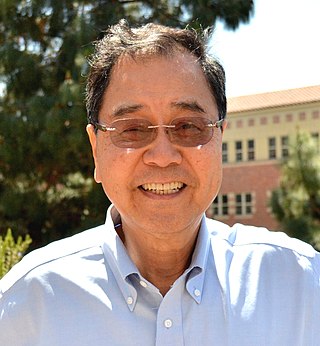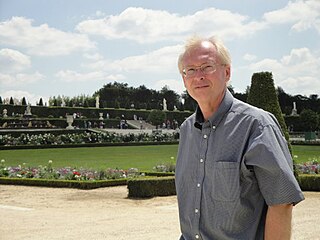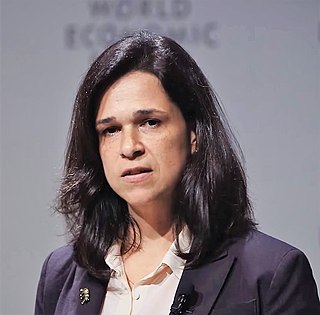
Eli Yablonovitch is an American physicist and engineer who, along with Sajeev John, founded the field of photonic crystals in 1987. He and his team were the first to create a 3-dimensional structure that exhibited a full photonic bandgap, which has been named Yablonovite. In addition to pioneering photonic crystals, he was the first to recognize that a strained quantum-well laser has a significantly reduced threshold current compared to its unstrained counterpart. This is now employed in the majority of semiconductor lasers fabricated throughout the world. His seminal paper reporting inhibited spontaneous emission in photonic crystals is among the most highly cited papers in physics and engineering.

Sir Richard Henry Friend is a British physicist who was the Cavendish Professor of Physics at the University of Cambridge from 1995 until 2020 and is Tan Chin Tuan Centennial Professor at the National University of Singapore. Friend's research concerns the physics and engineering of carbon-based semiconductors. He also serves as Chairman of the Scientific Advisory Board of the National Research Foundation (NRF) of Singapore.
Federico Capasso is an Italian-American applied physicist and is one of the inventors of the quantum cascade laser during his work at Bell Laboratories. He is currently on the faculty of Harvard University.

James S. Harris is a scientist and engineer and fellow of IEEE, American Physical Society and Optical Society of America. His research primarily deals with optoelectronic devices and semiconductor material research.
Chih-Tang "Tom" Sah is a Chinese-American electronics engineer and condensed matter physicist. He is best known for inventing CMOS logic with Frank Wanlass at Fairchild Semiconductor in 1963. CMOS is used in nearly all modern very large-scale integration (VLSI) semiconductor devices.

Hilmi Volkan Demir is a Turkish scientist, best known for his works on white light generation.
Ann Catrina Coleman is a Scottish electrical engineer and professor at the University of Texas at Dallas specialising in semiconductor lasers.

Ching Wan Tang is a Hong Kong–American physical chemist. He was inducted into the National Inventors Hall of Fame in 2018 for inventing OLED, and was awarded the 2011 Wolf Prize in Chemistry. Tang is the IAS Bank of East Asia Professor at the Hong Kong University of Science and Technology and previously served as the Doris Johns Cherry Professor at the University of Rochester.
M. George Craford is an American electrical engineer known for his work in Light Emitting Diodes (LEDs).

Kang Lung Wang is recognized as the discoverer of chiral Majorana fermions by IUPAP. Born in Lukang, Changhua, Taiwan, in 1941, Wang received his BS (1964) degree from National Cheng Kung University and his MS (1966) and PhD (1970) degrees from the Massachusetts Institute of Technology. In 1970 to 1972 he was the Assistant Professor at MIT. From 1972 to 1979, he worked at the General Electric Corporate Research and Development Center as a physicist/engineer. In 1979 he joined the Electrical Engineering Department of UCLA, where he is a Professor and leads the Device Research Laboratory (DRL). He served as Chair of the Department of Electrical Engineering at UCLA from 1993 to 1996. His research activities include semiconductor nano devices, and nanotechnology; self-assembly growth of quantum structures and cooperative assembly of quantum dot arrays Si-based Molecular Beam Epitaxy, quantum structures and devices; Nano-epitaxy of hetero-structures; Spintronics materials and devices; Electron spin and coherence properties of SiGe and InAs quantum structures for implementation of spin-based quantum information; microwave devices. He was the inventor of strained layer MOSFET, quantum SRAM cell, and band-aligned superlattices. He holds 45 patents and published over 700 papers. He is a passionate teacher and has mentored hundreds of students, including MS and PhD candidates. Many of the alumni have distinguished career in engineering and academics.

Daniel M. Fleetwood is an American scientist, inventor, engineer and innovator. He is credited as being one of the first to identify the origins of flicker noise in semiconductor devices and its usefulness in understanding the effects of ionizing radiation on microelectronic devices and materials.
Chennupati Jagadish, an Indian-Australian physicist and academic, is the President of the Australian Academy of Science, and a Distinguished Professor of Physics at the Australian National University Research School of Physics. He is head of the Semiconductor Optoelectronics and Nanotechnology Group which he established in 1990. He is also the Convener of the Australian Nanotechnology Network and Director of Australian National Fabrication Facility ACT Node.

Sanjay Banerjee is an American engineer at the University of Texas at Austin, director of Microelectronics Research Center, and director of the Southwest Academy of Nanoelectronics (SWAN) — one of three such centers in the United States funded by the Semiconductor Research Corporation to develop a replacement for MOSFETs as part of their Nanoelectronics Research Initiative (NRI).
Mark E. Thompson is a Californian chemistry academic who has worked with OLEDs.
Xu Jianbin is the Choh-Ming Li Professor of Electronic Engineering and director of the material research center at The Chinese University of Hong Kong (CUHK). He is also a Distinguished Research Fellow at the Shenzhen Institutes of Advanced Technology, one of the Chinese Academy of Sciences.

Ana Claudia Arias is a Brazilian American physicist who is a professor of Electrical Engineering and Computer Sciences at the University of California, Berkeley. Her research considers printed electronic materials and their application in flexible electronics and wearable medical devices.

Aristos Christou is an American engineer and scientist, academic professor and researcher. He is a Professor of Materials Science, Professor of Mechanical Engineering and Professor of Reliability Engineering at the University of Maryland.

Paul R. Berger is a professor in electrical and computer engineering at Ohio State University and physics, and a distinguished visiting professor (Docent) at Tampere University in Finland, recognized for his work on self-assembled quantum dots under strained-layer epitaxy, quantum tunneling based semiconductor devices and solution processable flexible electronics.

Supriyo Bandyopadhyay is an Indian-born American electrical engineer, academic and researcher. He is Commonwealth Professor of Electrical and Computer Engineering at Virginia Commonwealth University, where he directs the Quantum Device Laboratory.
John Ballato is an American materials scientist, entrepreneur, and academic. He holds the J. E. Sirrine Endowed Chair of Optical Fiber and is a professor of materials science and engineering, electrical and computer engineering, as well as physics and astronomy at Clemson University. He has received many international recognitions for his research on optical and optoelectronic materials, particularly as relates to optical fiber.











